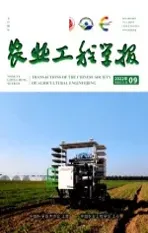Experimental analysis on mechanical model of industrial hemp stalk
2016-12-19ZhouYangLiXianwangShenChengTianKunpengZhangBinHuangJicheng
Zhou Yang, Li Xianwang, Shen Cheng, Tian Kunpeng, Zhang Bin, Huang Jicheng
(Nanjing Research Institute for Agricultural Mechanization, Ministry of Agriculture, Nanjing 210014, China)
Experimental analysis on mechanical model of industrial hemp stalk
Zhou Yang, Li Xianwang, Shen Cheng※, Tian Kunpeng, Zhang Bin, Huang Jicheng
(Nanjing Research Institute for Agricultural Mechanization, Ministry of Agriculture, Nanjing 210014, China)
In order to provide the mechanical parameters for the research on industrial hemp harvest machinery, the mechanical model for industrial hemp stalk is supposed with the knowledge of mechanics of composite material in the paper. To gain the mechanical parameters, the mechanical tests like tensile test, compressive test and bending test in the light of various directions and different fractions is carried out by utilizing the WDW-10 universal testing machine. All elastic parameters of mechanical model of industrial hemp stalk were achieved through analysis and calculation with composite material theory. All of the parameters were experimentally determined for industrial hemp stalks in order to find methods for mechanical harvest with minimum energy consumption. The xylem axis elasticity modulus is 1 343.5 MPa. The phloem radial elasticity modulus is 3 607.5 MPa. The stalk axis elasticity modulus are 1 743.50 MPa. The stalk radial compressive elasticity modulus is 88 MPa. The xylem shear modulus is 33.52 MPa. The stalk shear modulus is 31.99 MPa. According to the experiment, the hemp stalk has excellent mechanical properties, especially the performance of the phloem fiber. The test result of experiment shows that radial parameters of industrial hemp stalk accord with characteristics of composite material. It is a significant guidance in hemp cutter design. This study provided a theoretical foundation for in-depth exploration on hemp cutter design and optimization to make the hemp harvester satisfy the working requirement of high quality and low consumption.
models; composite materials; elasticity; industrial hemp; stalk; experiments
Biography:Zhou Yang, Male, Liaoning Province, Engaged in research on agricultural mechanization engineering. Nanjing Nanjing Research Institute for Agricultural Mechanization, Ministry of Agriculture, 210014. Email:347100380@qq.com
※Corresponding Author:Shen Cheng, Male, Zhejiang Province, Assistant Professor, Engaged in research on agricultural mechanization engineering. Nanjing Nanjing Research Institute for Agricultural Mechanization, Ministry of Agriculture, 210014. Email:shencheng1989@cau.edu.cn. Member of the Chinese Society of Agricultural Engineering: Shen Cheng (E041100063M)
0 Introduction
At present, the nations of cultivation of industrial hemp in the world about 30. Currently the main hemp producing regions in the world are China, Europe, and Canada[1]. For a long time, China has always been the largest hemp producing country in the world, with the planting area and output of hemp occupying over 30% of total amount in the world[2]. Hemp fiber is shorter than ramie and cotton fiber[3]. But, it has incomparable superiorities as a textile material. As an excellent natural material of textile fiber, it enjoys a high reputation all around the world.
Hemp is a more sustainable annual energy crop[4]. In some respects during the whole production process of hemp, The quality of harvesting and fiber peeling are difficult to be controled. At present stage, we need more efficient hemp crops harvest and peeling machine[5-6]. In recent years, Institute of Bast Fiber Crops, Chinese Academy of Agricultural Sciences and Nanjing Research Institute for Agricultural Mechanization, Ministry of Agriculture have conducted a large number of researches in mechanized harvesting and mechanical peeling[7-9]. Predecessor mostly carried out cutter and drying experiment, but lack of the study of mechanical properties of the materials[10-12]. The mechanical properties of crops fiber directly affect the working effect of equipment. Existing equipment cannot realize the purposes of high-quality, efficient and low-consumption. Ramie and hemp stalk have a big difference in physical properties and application. Hemp stalk is thicker and stronger than ramie stalk, so the modulus parameters are higher than ramie. It is also a significant guidance in hemp cutter design[13].The purpose of the experiment is to reveal the essence of hemp harvesting from mechanical mechanism aspects.
This study provided a theoretical foundation for in-depth exploration on hemp cutter design and optimization combining test with calculation analysis, constitutive relation and material characteristics of hemp stalk were determining. In order to meet the purposes of the experiment, experimental process refer to the method of analyzing mechanical properties of stalk crops[14-16], like ramie, sugarcane, corn artemisia and sunflower stalk[17-20]. The paper established the mechanical model of crop stalk via composite material mechanics theory[21-22].
1 Method of establishing mechanical model of stalk and determining parameters
1.1 Assumption of geometrical model
The cross section of hemp stalk approximates roundness, and the cross section is composed of central medulla, xylem, bast fiber layer (phloem) and green husk layer from inside to outside, as shown in Fig.1a.

Fig.1 Geometrical model of hemp
Central medulla is cystose, with loose structural tissue and irregular shape. Green layer is thin and crisp. Mechanical properties of these two can be ignored when compared with other parts. Hemp stalk has great differences among individuals and various parts, so its geometrical shape should be abstracted and simplified. It was supposed that section of hemp was a circular cross section with a certain diameter, and the material, diameter and wall thickness of different components were uniform. After central medulla and green husk layer were ignored, the geometrical shape of hemp would be a hollowed circular tube, composed of xylem and phloem which had different materials. Besides, a coordinate axis was established; Z axis was set up at the axial direction of stalk, and X axis and Y axis were established at the radial direction (as shown in Fig.1b).
1.2 Elastic parameters of constitutive relation
According to composite material mechanics theory, fractional characteristics of orthogonal anisotropic materials can be characterized by 9 engineering elastic parameters: axial elasticity modulus EZand radial elasticity modulus EXand EY; connatural plane axial shear modulus GXYand anisotropic plane axial shear modulus GYZand GXZ; connatural plane Poisson's ratio μXYand anisotropic plane Poisson's ratio μYZand μXZ. According to the geometrical shape assumption of hemp, hemp has characteristic of axis rotation and possesses an orthogonal & symmetric interface. Thus it is equipped with characteristics of transverse orthogonal anisotropic materials. Its engineering elastic parameters meet formula (1).
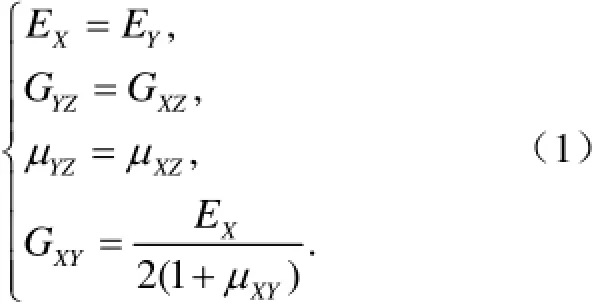
Where EX, EYare radial elasticity modulus ,MPa; GXYis connatural plane axial shear modulus, MPa; GYZ, GXZare nisotropic plane axial shear modulus, MPa; μXYis connatural plane Poisson’s ratio; μYZand μXZare anisotropic plane Poisson’s ratio.
1.3 Theoretical method of elastic parameter determination
1) Firstly, external diameter, inner diameter and phloem thickness of hemp stalk samples were determined, and the volume ratios VM, VRof hemp stalk xylem and phloem to stalk were calculated according to formula (2).

Where D is external diameter, mm; d is inner diameter, mm; h is phloem thickness, mm; VMand VRare the volume ratios.
2) Elasticity modulus E can be gained by stress and strain according to formula (3). It need to be gotten from linear part of the curve after adjustment of curve.

Where E is elasticity modulus, MPa; σ is stress in MPa; ε is strain.
3) Axial tension test was conducted for various components via PC-controlled universal testing machine, to gain axial tensile elasticity modulus EZ2, EZ3and EZ1of xylem, phloem and stalk. Meanwhile, axial tensile elasticity modulus of various components was tested by utilizing the relational expression of composite material engineering constant (formula (4))[23].

Where EZi(i=1, 2, 3) is axial elasticity modulus, MPa.
4) Radial compression test was conducted for hemp stalk sample via PC-controlled universal testing machine, to gain radial compressive elasticity modulus EX1of stalk.
5) Radial three-point bending test was conducted for xylem and stalk of hemp stalk sample via PC-controlled universal testing machine. By referring to the calculation formula of circular tube shear stiffness (formula (5)) and calculation formula of circular tube shear modulus (formula (6)) in Test Method for Flexural Properties of Sandwich Constructions (GB1456-2005), radial shear stiffness UYZ2& UYZ1and bending shear modulus GYZ2& GYZ1of xylem and stalk were obtained[24].

Where U is shear stiffness, N; Δp represents load increment of elastic stage, N; L denotes span, mm; f indicates mid-span deflection increment, mm; f1refers to epitaxial deflection increment, mm; a means extrapolation length, mm.

Where G is bending shear modulus, MPa.
Bending shear modulus GYZ2and GYZ1of hemp xylem and stalk could be gained according to formula (7). Three-point bending test could not be conducted for hemp phloem, so its bending shear modulus must be calculated via the formula. According to the relational expression of composite material engineering constant, bending shear modulus GYZ3of hemp phloem could be derived. The derivation process is presented by formula (7).

Where GYZ2and GYZ1are bending shear modulus of hemp xylem and stalk, MPa; GYZ3is bending shear modulus of hemp phloem, MPa.
6) Axial torsional shear modulus could not be measured via PC-controlled universal testing machine. Therefore, connatural plane Poisson’s ratio μXY2, μXY3and μXY1of hemp stalk xylem, phloem and stalk were assumed as 0.3 by referring to Poisson's ratio of similar materials and combining with previous material research[25]. Then the axial torsional shear modulus GXYwas gained through formula (1).
7) Parameter relationship (formula (8)) of orthogonal anisotropic material was derived according to composite material mechanics theory, and meanwhile anisotropic plane Poisson's ratio μYZwas derived according to the values of radial compressive elasticity modulus EX, axial tensile elasticity modulus EZand connatural plane Poisson's ratio μXY.

Where μYZis anisotropic plane Poisson's ratio; μXYis connatural plane Poisson's ratio.
2 Mechanical test
2.1 Test equipment and materials
2.1.1 Test equipment
WDW-10 PC-controlled universal testing machine was adopted as mechanical test equipment, and see Fig.2a. Tensile and bending test force range was 2 kN and compressive test force range was 10 kN. The precision of force sensor and displacement sensor was within ±0.1%. Both universal testing machine and sensors are producted by Jinan Chuanbai Instrument Co., Ltd. In addition, other auxiliary tools included test fixture, vernier caliper, ruler, and inductive moisture instrument.
2.1.2 Test materials
Hemp of “Anhui Hemp No. 1” planted in Lu’an Hemp Comprehensive Test Station of China Agriculture Research System was selected and collected on 19 Jul, 2015.Test materials were cut from mature stem less than 30 cm from the bottom of hemp, and see Fig.2b.
Eighty straight and healthy hemp stalks were selected as test materials. The external diameter and inner diameter at 25 cm above the bottom were measured, and phloem thickness after phloem was separated was measured. The average value was gained through data statistics. The average D of hemp stalk is 16.44 mm, the average d is 9.15 mm, and the averaged h of phloem is 0.61 mm, and see Table 1 for the test data. The volume ratio VMof xylem to stalk was calculated according to formula (2), and its value is 0.793; at the same time, the volume ratio VRof phloem to stalk was 0.207.
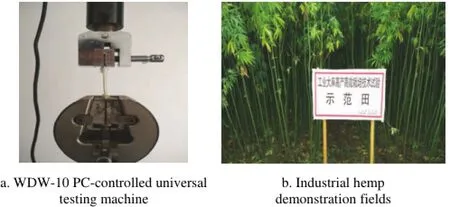
Fig.2 Test equipment and test materials

Table 1 Measurement data of physical components of hemp stalks
The moisture content of experimental stem material about 66.33%-72.21%.
2.2 Test method
2.2.1 Tensile test
The xylem, phloem and stalk samples were cut into rectangles with the length of 90 mm and width of 7-8 mm; the thickness remained unchanged and depended on the materials. Plate fixture was used to clamp the test materials, and the clamping part was wrapped with gauze to protect clamping part of the material. Pretension force (<5 N) was initiated, loading velocity of the test was 2 mm/min, and the test for xylem, phloem and stalk samples was repeated for 20 groups. Fracture damage occurred in the middle of sample. Elastic modulus of various tensile parameters can be gained by combining with formula (3).
2.2.2 Compressive test
The radial compressive stalk samples were cut into rectangles with the length of 10 mm and width of 6 mm; the thickness remained unchanged and depended on the materials. The axial compressive stalk test samples were cut into 20 cm long and the diameter remained unchanged and depended on the materials. Squeezing block was applied on the test samples, pretension force (<5 N) was initiated, loading velocity of the test was 0.5 mm/min, and the test for xylem, phloem and stalk samples was repeated for 10 groups. Elastic modulus of various compressive parameters can be gained by combining with formula (3).
2.2.3 Bending test
Xylem and stalk samples were test samples with the length of 110 mm, cross section of the test samples was tubular, and the external diameter and inner diameter depended on the materials. Geometrical parameters (external diameter and inner diameter) of various samples were measured via vernier caliper and the data were recorded. The samples were put between the support and pressure head of three-point bending test fixture, and span L of the support was 70 mm. Pretension force (<5 N) was initiated, loading velocity of the test was 5 mm/min, and the test for xylem and stalk samples was repeated for 10 groups.
2.3 Test results
2.3.1 Axial tensile test data about various components of stalk
Axial tensile test was conducted for 20 groups of xylem, phloem and stalk samples. See Fig.3 for the stress-strain curves, and see Table 2.
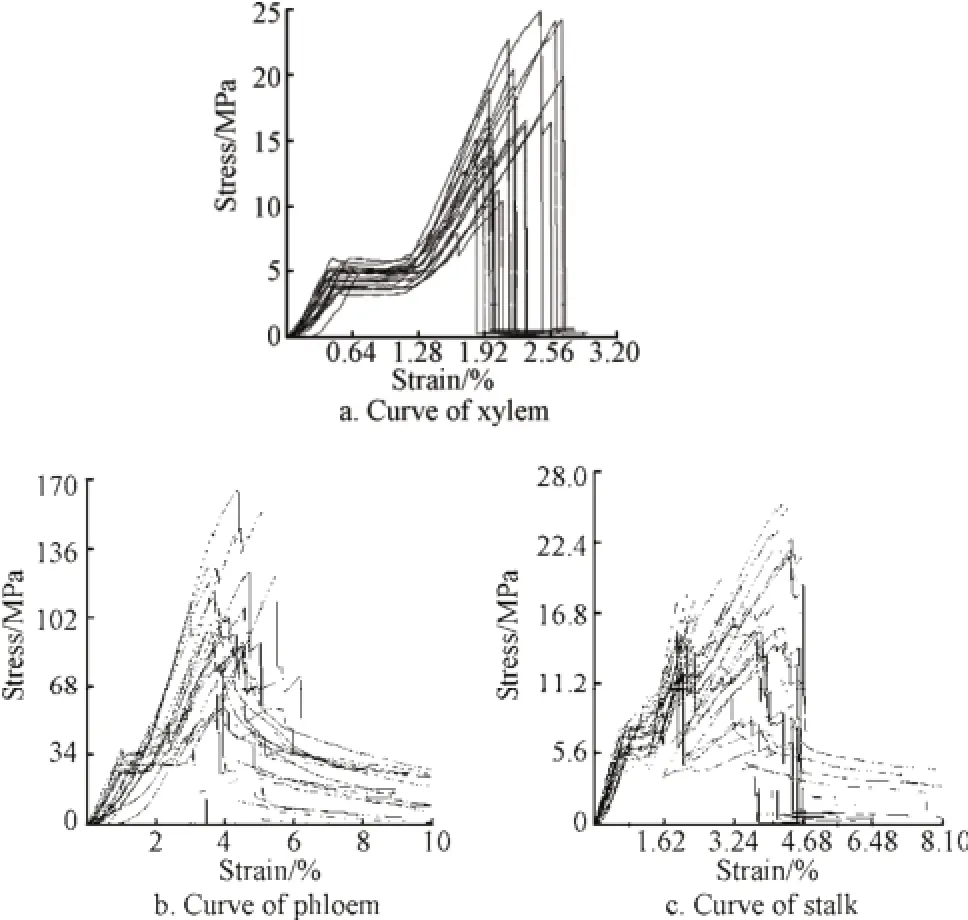
Fig.3 Axial tensile stress-strain curve
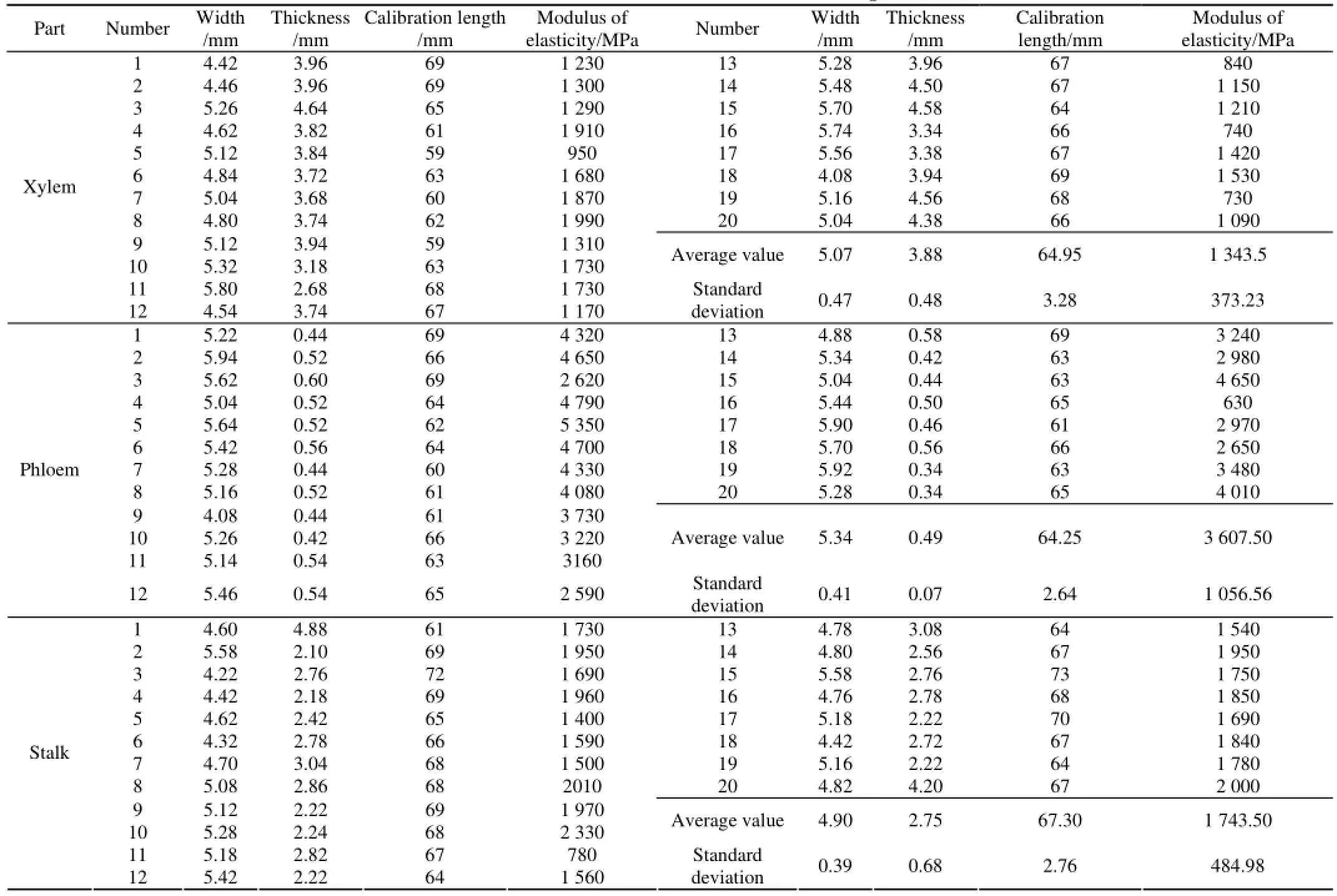
Table 2 Data of axial tensile test of hemp
Fig.3 presents exponentially increasing relationship between stress and strain. The curves have tendency of ascending first and sudden descending because of hemp fiber fractured gradually. The valid data needs to be gotten from linear part of the curve after adjustment of curve.
According to the statistical calculation of axial tensile test, the average value of elasticity modulus EZ2in xylem is 1 343.50 MPa, the standard deviation is 373.23 MPa, the maximum value EZ2maxis 1 990 MPa, and the minimum value EZ2minis 730 MPa. The average value of elasticity modulus EZ3in phloem is 3 607.50 MPa, the standard deviation is 1 056.56 MPa, the maximum value EZ3maxis 5 350 MPa, and the minimum value EZ3minis 630 MPa. The average value of elasticity modulus EZ1in stalk is 1 743.50 MPa, the standard deviation is 484.98 MPa, the maximum value EZ1maxis 2 330 MPa, and the minimum value EZ1minis 780 MPa.
2.3.2 Radial compressive test data about stalk
Fig.4 presents linear growth relationship between stress and strain. The valid data needs to be gotten from linear part of the curve after adjustment of curve. Radial compressive test was conducted for 10 groups of stalk samples. See Fig. 4 for the stress-strain curves, and see Table 3 for the test data.
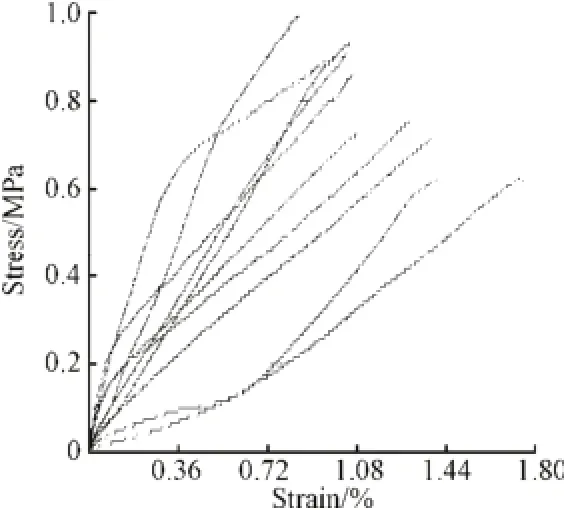
Fig.4 Radial compressive stress-strain curve

Table 3 Radial compressive result of hemp stalk
2.3.3 Axial compressive test data about various components of stalk
Fig.5 presents exponentially increasing relationship between stress and strain because of the woody structure broken in compression gradually. The valid data needs to be gotten from linear part of the curve after adjustment of curve. Axial compressive test was conducted for 10 groups of xylem, phloem and stalk samples. See Fig.4 for the stress-strain curves, and see Table 4 for the test data.
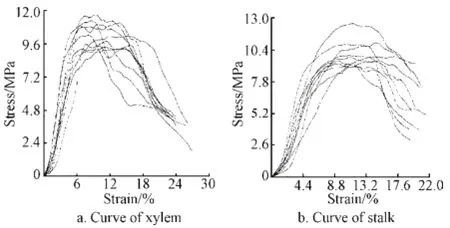
Fig.5 Axial compressive stress-strain curve
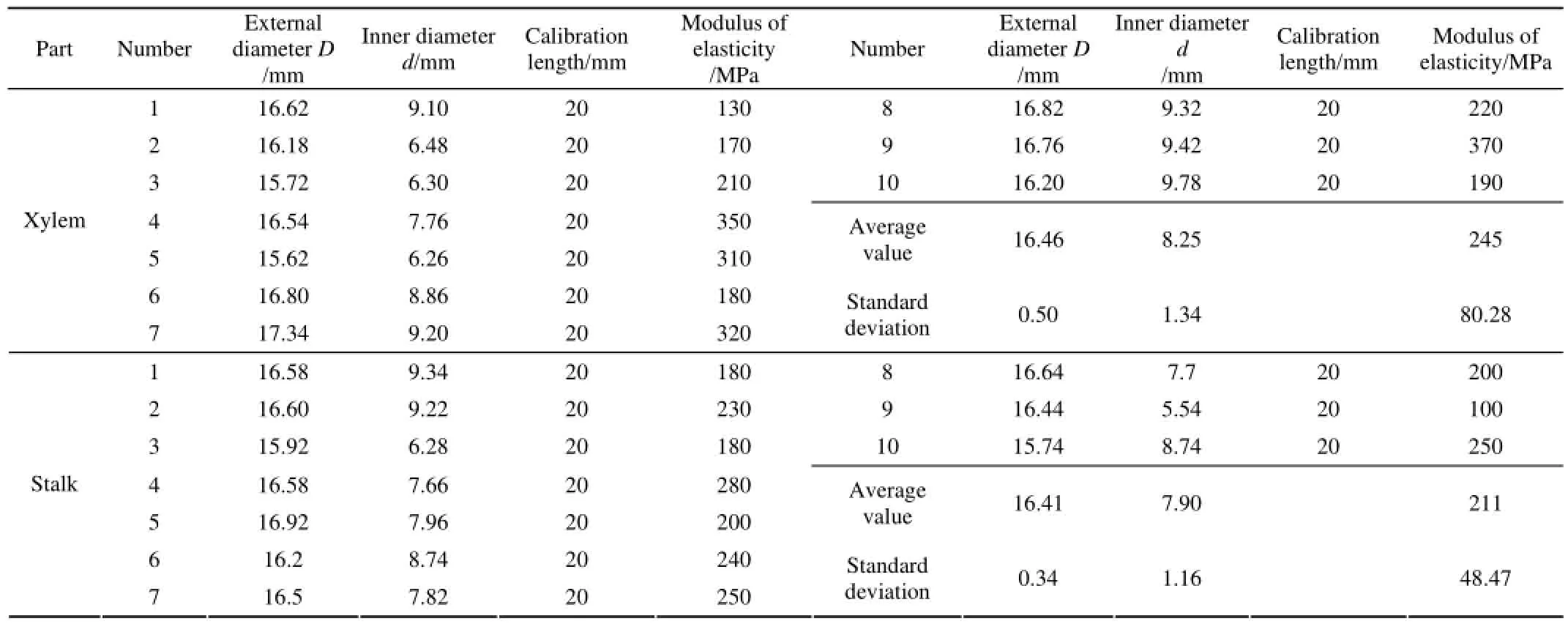
Table 4 Data of axial compressive test of hemp
2.3.4 Radial bending test data about various components of stalk
Radial bending test was conducted for 10 groups of xylem and stalk samples. See Fig.6 for the stress-strain curves, and see Table 5 for the test data.
Fig.6 presents exponentially increasing relationship between force and deformation. The valid data needs to be gotten from linear part of the curve after adjustment of curve. According to the statistical calculation of radial bending test, the average value of shear modulus GXZ2in xylem is 33.52 MPa, the standard deviation is 11.99 MPa, the maximum value GXZ2maxis 61.38 MPa, and the minimum value GXZ2minis 19.45 MPa. The average value of shear modulus GXZ1in stalk is 31.99 MPa, the standard deviation is 9.56 MPa, the maximum value GXZ1maxis 48.85 MPa, and the minimum value GXZ1minis 16.76 MPa.
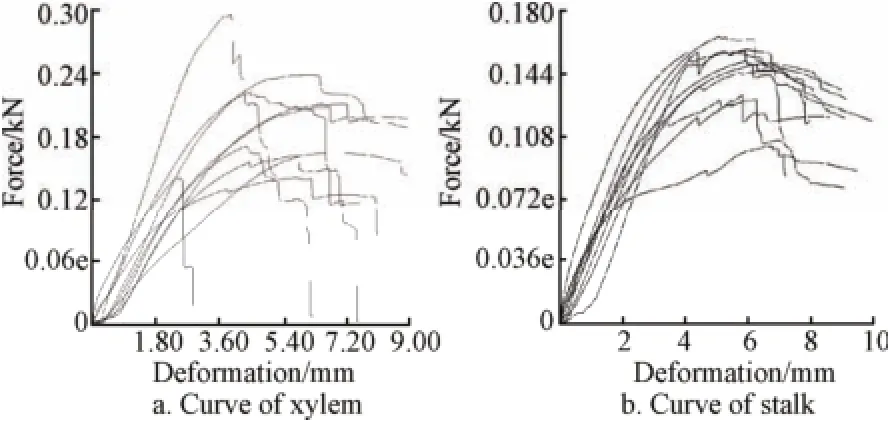
Fig.6 Radial bending force-deformation curve

Table 5 Data of radial bending test of hemp
3 Result analysis
3.1 Elastic parameters gained in the test
The average diameter D of hemp stalk bottom is 16.44 mm, the inner diameter d is 9.15 mm, and the thickness h of phloem is 0.61 mm; the volume ratios of hemp stalk xylem and phloem to stalk are VM=0.793 and VR=0.207.
Axial tensile elasticity modulus: xylem EZ2=1 343.5 MPa, phloem EZ3=3 607.5 MPa and stalk EZ1=1 743.50 MPa.
Radial compressive elasticity modulus: Stalk EX1= 88 MPa.
Anisotropic plane bending shear modulus: xylem GXZ2=33.52 MPa and stalk GXZ1=31.99 MPa.
Connatural plane Poisson’s ratio: xylem μXY2, phloem μXY3and stalk μXY1are 0.3.
3.2 Elastic parameters gained in calculation
By substituting the values of EX1and μXY1into formula (1), connatural plane torsional shear modulus of various hemp stalk components can be gained: stalk GXY1=33.85 MPa.
By substituting the values of GYZ1, GYZ2, VMand VRinto formula (7), anisotropic plane bending shear modulus of hemp phloem can be gained: GYZ3=32.28 MPa.
By substituting the results into formula (8), anisotropic plane Poisson’s ratio can be obtained: stalk μYZ1<0.0252.
3.3 Parameter analysis
By integrating the elastic parameters gained in test and calculation together, elastic parameters of various hemp stalk components can be gained by combining with formula (1), as shown in Table 6.

Table 6 Elastic parameters of each part of hemp stalk
By substituting the values of EZ2, EZ3, VMand VRinto formula (4), it is obtained that EZ1calculation=1 812.148 MPa, while the value measured in the test is EZ1=1 743.50 MPa. These two have a difference, and the actually measured value EZ1approximates EZ2more. As for the reason, xylem and phloem of hemp are stuck together by relying on their own adhesive power, and the adhesive power cannot stop phloem from slipping on the surface layer of xylem. Because of different shapes, axial compressive elasticity modulus much larger than radial compressive elasticity modulus. At the same time, in bending test, the load-bearing effect of xylem is mainly reflected. Because of axial compressive without the influence factor, axial compressive modulus is much lower than axial tensile modulus.
4 Conclusions
The mechanical model of hemp stalk was assumed via composite material mechanics theory, data of mechanical parameters were obtained through mechanical test, and elastic parameters of various hemp stalk components were gained via data analysis and calculation. The xylem axis elasticity modulus is 1 343.5 MPa. The phloem radial elasticity modulus is 3 607.5 MPa. The stalk axis elasticity modulus are 1 743.50 MPa. The stalk radial compressive elasticity modulus is 88 MPa. The xylem shear modulus is 33.52 MPa. The stalk shear modulus is 31.99 MPa. The test result of experiment shows that radial parameters of hemp stalk accord with characteristics of composite material. And the results were experimentally determined for industrial hemp stalks in order to find methods for mechanical harvest with minimum energy consumption.
[Reference]
[1] Salentijn E M J, Zhang Qingying, Amaducci S, et al. New developments in fiber hemp (Cannabis sativa L.) breeding[J]. Industrial Crops and Products, 2015, 68(3): 32-41.
[2] Wu Hongling, Jiang Shaojun, Ding Liwen. Property of hemp fiber and development of its product[J]. Wood textile Journal 2004, 32(6): 36-39. (in Chinese with English abstract)
[3] Huang Cuirong, Yu Weidong. The spinning capability of hemp fiber and the studying getting on[J]. Journal of Wuhan University of Science and Engineering, 2006, 19(1): 35-38. (in Chinese with English abstract)
[4] Finnan J, Styles D. Hemp: A more sustainable annual energy crop for climate and energy policy[J]. Energy Policy, 2013, 58(4): 152-162.
[5] Lu Jiangnan, Long Chaohai, Ma Lan, et al. Research progress and suggestions on mechanized equipments for bast fiber crops in China[J]. Plant Fibers and Productions, 2013, 35(6): 307-312. (in Chinese with English abstract)
[6] Liu Lijun, Lao Chengying, Zhang Na, et al. The effect of new continuous harvest technology of ramie (Boehmeria nivea L. Gaud.) on fiber yield and quality[J]. Industrial Crops and Products, 2013, 44(2): 677-683.
[7] Long Chaohai, Lu Jiangnan, Ma Lan, et al. Research and application of ramie decorticating and processing machine[J]. Hunan Agricultural Machinery, 2011, 38(1): 1-4. (in Chinese with English abstract)
[8] Li Xianwang, Zhang Bin, Wang Jinguo, et al. Design and experiment of crawler ramie combine harvester[J]. Chinese Agricultural Mechanization, 2013, 34(1): 123-125, 133. (in Chinese with English abstract)
[9] Huang Jicheng, Li Xianwang, Zhang Bin, et al. Research on the 4LMZ160 crawler ramie combine harvester[J]. Journal of Agricultural Mechanization Research, 2015, 37(9): 155-163. (in Chinese with English abstract)
[10] Li Xiaoping, Wang Siqun, Du Guanben, et al. Variation in physical and mechanical properties of hemp stalk fibers along height of stem[J]. Industrial Crops and Products, 2013, 42(1): 344-348.
[11] Beaugrand J, Nottez M, Konnerth J, et al. Multi-scale analysis of the structure and mechanical performance of woody hemp core and the dependence on the sampling location[J]. Industrial Crops and Products, 2014, 60(60): 193-204.
[12] Marrot L, Lefeuvre A, Pontoire B, et al. Analysis of the hemp fiber mechanical properties and their scattering (Fedora 17)[J]. Industrial Crops and Products, 2013, 51(6): 317-327.
[13] Shen Cheng, Li Xianwang, Tian Kunpeng, et al. Experimental analysis on mechanical model of ramie stalk[J]. Transactions of the Chinese Society of Agricultural Engineering (Transactions of the CSAE), 2015, 31(20): 26-33. (in Chinese with English abstract).
[14] Kronbergs E. Mechanical strength testing of stalk materials and compacting energy evaluation[J]. Industrial Crops & Products, 2000, 11(2): 211-216.
[15] Aarseth K A, Prestløkken E. Mechanical properties of feed pellets: Weibull analysis[J]. Biosystems Engineering, 2003, 84(3): 349-361.
[16] Su Gongbing. Mechanical Modeling and Analysis of Finite Element Method for Ramie Stalk[D]. Huazhong Agricultural University, 2007. (in Chinese with English abstract)
[17] Liu Qingting, Ou Yinggang, Qing Shangle, et al.Cutting force test of sugarcane stalk[J]. Transactions of the Chinese Society of Agricultural Engineering (Transactions of the CSAE), 2007, 23(7): 91-94. (in Chinese with English abstract)
[18] Li Yaoming, Qin Tongdi, Chen Jin, et al. Experiments and analysis on mechanical property of corn stalk reciprocating cutting[J]. Transactions of the Chinese Society of Agricultural Engineering (Transactions of the CSAE), 2011, 27(1): 160-164. (in Chinese with English abstract)
[19] Chen Cong, Zhu Haifeng, Zhou Yabo, et al. Experimentl study on mechanical properties of artemisia annua stem test[J]. Hunan Agricultural Michinery, 2014, 40(3) : 159-161. (in Chinese with English abstract)
[20] İnce A, Uğurluay S, Güzel E, et al. Bending and shearing characteristics of sunflower stalk residue[J]. Biosystems Engineering, 2005, 92(2): 175-181.
[21] Liu Qingting, Qu Yinggang, Qing Shangle, et al. Study progress on mechanics properties of crop stalks[J]. Transactions of The Chinese Society for Agricultural Machinery, 2007, 23 (7): 172-176. (in Chinese with English abstract)
[22] Ma Fanzhong, Liu Jizhan. Review on mechanical testing of crop stalks[J]. Journal of Agricultural Mechanization Research, 2014, 36(8): 5-9. (in Chinese with English abstract)
[23] Wang Shijie. Compound Material Mechanics[M]. Chongqing: Chongqing University Press, 1987.
[24] Zhou Zhulin, Wan Yousheng, Yang Yundi, et al. Expanded application of state standard GB1456, 1997[C]//Composite Academic Essays. (in Chinese with English abstract)
[25] Liu Zhaopeng, Xie Fangping, Wu Mingliang, et al. Study of mechanical property parameters of ramie bottom stalk in harvesting period[J]. Journal of Hunan Agricultural University: Natural Sciences, 2011, 37(3): 329-332. (in Chinese with English abstract)
工业大麻茎秆力学模型的试验分析
周 杨,李显旺,沈 成※,田昆鹏,张 彬,黄继承
(农业部南京农业机械化研究所,南京 210014)
为了促进工业大麻产业的快速发展,为大麻收获机械的研究与设计提供物料的机械性能参数指标,作为收获机具的研究依据,该文通过综合利用复合材料力学的基础知识对工业大麻茎秆的机械物理模型进行假定,再利用WDW-10万能试验机对工业大麻茎秆各组成部分分别进行轴向拉伸、轴向和径向压缩、径向弯曲等力学性能的试验,从而获得工业大麻茎秆的力学性能数据,再通过复合材料理论的基础知识进行综合分析与计算,获得工业大麻茎秆力学模型的性能参数,最后通过比较分析得出假定的数学模型基本可靠。通过试验得到的木质部轴向弹性模量为1 343.5 MPa,韧皮层径向弹性模量为3 607.5 MPa,茎秆的轴向弹性模量为1 743.50 MPa,茎秆的径向压缩弹性模量为88 MPa,木质部异性面弯剪模量为33.52 MPa,茎秆异性面弯剪模量为31.99 MPa,木质部、韧皮层、茎秆的同性面泊松比为0.3。通过试验数据可以看出,大麻茎秆的各组成部分具有优异的机械性能,其中韧皮纤维的机械性能尤其突出。试验结果表明,工业大麻茎秆径向结构符合复合材料的特性。通过测量工业大麻的力学性能参数,可为优化工业大麻收获机具的强度与刚度提供参考,使机具在收获过程中的功耗最少、割茬质量最高。
模型;复合材料;弹性;工业大麻;茎秆;试验
10.11975/j.issn.1002-6819.2016.09.004
S563.3; S225.91+3
A
1002-6819(2016)-09-0022-08
Zhou Yang, Li Xianwang, Shen Cheng, Tian Kunpeng, Zhang Bin, Huang Jicheng. Experimental analysis on mechanical model of industrial hemp stalk[J]. Transactions of the Chinese Society of Agricultural Engineering (Transactions of the CSAE), 2016, 32(9): 22-29. (in English with Chinese abstract)
10.11975/j.issn.1002-6819.2016.09.004 http://www.tcsae.org
周 杨,李显旺,沈 成,田昆鹏,张 彬,黄继承. 工业大麻茎秆力学模型的试验分析[J]. 农业工程学报,2016,32(9):22-29. doi:10.11975/j.issn.1002-6819.2016.09.004 http://www.tcsae.org
date:2015-10-17 Revision date:2016-03-01
Fund of China Agricultural Research System (CARS-19-E22); The Agricultural Science and Technology Innovation Program of Chinese Academy of Agricultural Sciences (ASTIP,CAAS)
